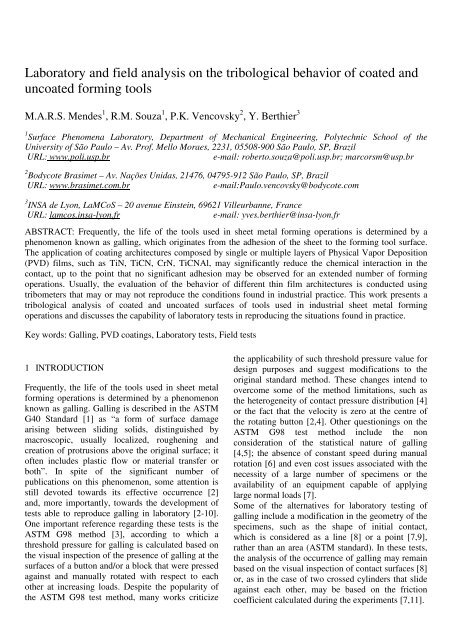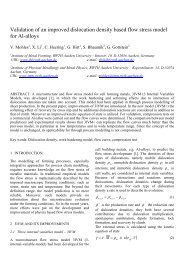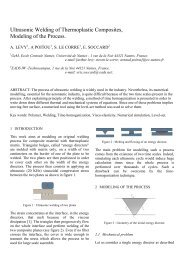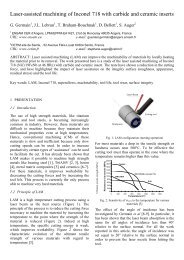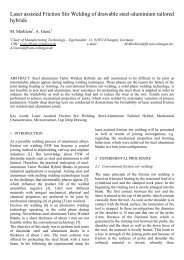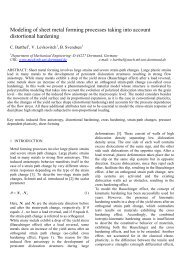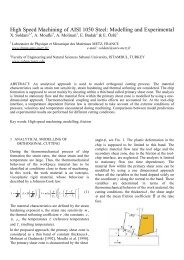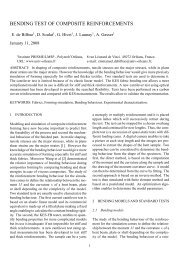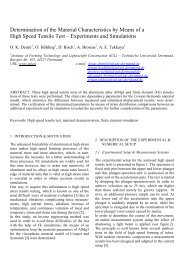Here - the ESAFORM 2008 Conference - INSA de Lyon
Here - the ESAFORM 2008 Conference - INSA de Lyon
Here - the ESAFORM 2008 Conference - INSA de Lyon
You also want an ePaper? Increase the reach of your titles
YUMPU automatically turns print PDFs into web optimized ePapers that Google loves.
Laboratory and field analysis on <strong>the</strong> tribological behavior of coated anduncoated forming toolsM.A.R.S. Men<strong>de</strong>s 1 , R.M. Souza 1 , P.K. Vencovsky 2 , Y. Berthier 31 Surface Phenomena Laboratory, Department of Mechanical Engineering, Polytechnic School of <strong>the</strong>University of São Paulo – Av. Prof. Mello Moraes, 2231, 05508-900 São Paulo, SP, BrazilURL: www.poli.usp.bre-mail: roberto.souza@poli.usp.br; marcorsm@usp.br2 Bodycote Brasimet – Av. Nações Unidas, 21476, 04795-912 São Paulo, SP, BrazilURL: www.brasimet.com.bre-mail:Paulo.vencovsky@bodycote.com3 <strong>INSA</strong> <strong>de</strong> <strong>Lyon</strong>, LaMCoS – 20 avenue Einstein, 69621 Villeurbanne, FranceURL: lamcos.insa-lyon.fre-mail: yves.berthier@insa-lyon.frABSTRACT: Frequently, <strong>the</strong> life of <strong>the</strong> tools used in sheet metal forming operations is <strong>de</strong>termined by aphenomenon known as galling, which originates from <strong>the</strong> adhesion of <strong>the</strong> sheet to <strong>the</strong> forming tool surface.The application of coating architectures composed by single or multiple layers of Physical Vapor Deposition(PVD) films, such as TiN, TiCN, CrN, TiCNAl, may significantly reduce <strong>the</strong> chemical interaction in <strong>the</strong>contact, up to <strong>the</strong> point that no significant adhesion may be observed for an exten<strong>de</strong>d number of formingoperations. Usually, <strong>the</strong> evaluation of <strong>the</strong> behavior of different thin film architectures is conducted usingtribometers that may or may not reproduce <strong>the</strong> conditions found in industrial practice. This work presents atribological analysis of coated and uncoated surfaces of tools used in industrial sheet metal formingoperations and discusses <strong>the</strong> capability of laboratory tests in reproducing <strong>the</strong> situations found in practice.Key words: Galling, PVD coatings, Laboratory tests, Field tests1 INTRODUCTIONFrequently, <strong>the</strong> life of <strong>the</strong> tools used in sheet metalforming operations is <strong>de</strong>termined by a phenomenonknown as galling. Galling is <strong>de</strong>scribed in <strong>the</strong> ASTMG40 Standard [1] as “a form of surface damagearising between sliding solids, distinguished bymacroscopic, usually localized, roughening andcreation of protrusions above <strong>the</strong> original surface; itoften inclu<strong>de</strong>s plastic flow or material transfer orboth”. In spite of <strong>the</strong> significant number ofpublications on this phenomenon, some attention isstill <strong>de</strong>voted towards its effective occurrence [2]and, more importantly, towards <strong>the</strong> <strong>de</strong>velopment oftests able to reproduce galling in laboratory [2-10].One important reference regarding <strong>the</strong>se tests is <strong>the</strong>ASTM G98 method [3], according to which athreshold pressure for galling is calculated based on<strong>the</strong> visual inspection of <strong>the</strong> presence of galling at <strong>the</strong>surfaces of a button and/or a block that were pressedagainst and manually rotated with respect to eacho<strong>the</strong>r at increasing loads. Despite <strong>the</strong> popularity of<strong>the</strong> ASTM G98 test method, many works criticize<strong>the</strong> applicability of such threshold pressure value for<strong>de</strong>sign purposes and suggest modifications to <strong>the</strong>original standard method. These changes intend toovercome some of <strong>the</strong> method limitations, such as<strong>the</strong> heterogeneity of contact pressure distribution [4]or <strong>the</strong> fact that <strong>the</strong> velocity is zero at <strong>the</strong> centre of<strong>the</strong> rotating button [2,4]. O<strong>the</strong>r questionings on <strong>the</strong>ASTM G98 test method inclu<strong>de</strong> <strong>the</strong> nonconsi<strong>de</strong>ration of <strong>the</strong> statistical nature of galling[4,5]; <strong>the</strong> absence of constant speed during manualrotation [6] and even cost issues associated with <strong>the</strong>necessity of a large number of specimens or <strong>the</strong>availability of an equipment capable of applyinglarge normal loads [7].Some of <strong>the</strong> alternatives for laboratory testing ofgalling inclu<strong>de</strong> a modification in <strong>the</strong> geometry of <strong>the</strong>specimens, such as <strong>the</strong> shape of initial contact,which is consi<strong>de</strong>red as a line [8] or a point [7,9],ra<strong>the</strong>r than an area (ASTM standard). In <strong>the</strong>se tests,<strong>the</strong> analysis of <strong>the</strong> occurrence of galling may remainbased on <strong>the</strong> visual inspection of contact surfaces [8]or, as in <strong>the</strong> case of two crossed cylin<strong>de</strong>rs that sli<strong>de</strong>against each o<strong>the</strong>r, may be based on <strong>the</strong> frictioncoefficient calculated during <strong>the</strong> experiments [7,11].


